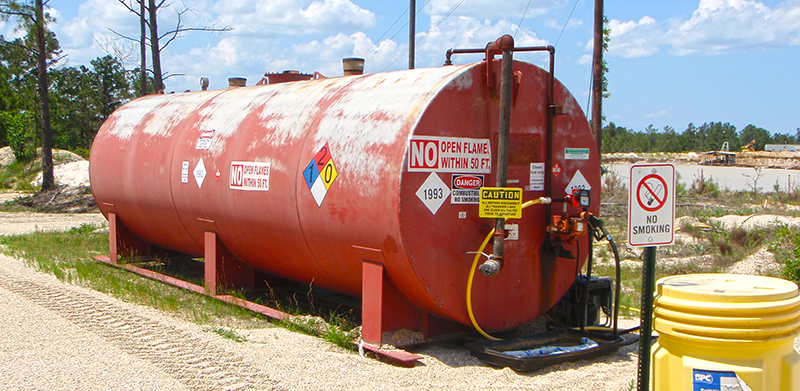
SPCC Plans
McInnis Provides SPCC (Spill Prevention, Control, and Countermeasure) plans for both Tier I and II Facilities
What is the SPCC rule?
The SPCC rule, promulgated by the United States Environmental Protection Agency (EPA), is designed to help prevent oil discharges into U.S. navigable waters and adjoining shorelines. Specifically, the rule requires that certain facilities storing, using, or handling oil or oil‐products prepare, maintain, and implement an oil spill prevention plan, commonly referred to as an SPCC Plan. The idea is both to help facilities prevent spills in the first place and to ensure they are ready to respond if a discharge does occur.
Who must comply?
Facilities must comply with the SPCC rule if they meet the following criteria:
They store, transfer, use, or consume oil or oil‐products (for example: diesel fuel, gasoline, lube oil, hydraulic oil, animal fats, vegetable oils).
They have an aggregate aboveground oil storage capacity of more than 1,320 U.S. gallons in containers of 55 gallons or greater, or more than 42,000 gallons in completely buried containers.
They could reasonably be expected to discharge oil to navigable waters of the U.S. or adjoining shorelines. Factors include site geography, drainage, runoff or precipitation that might carry oil to water bodies.
If all of these apply, the facility is covered by the SPCC rule and must prepare an SPCC Plan.
What must an SPCC Plan include?
An SPCC Plan is essentially the facility’s blueprint for preventing and responding to oil discharges. Key elements include:
Facility description: location, operations, oil‐handling activities, storage tanks (capacity, contents, locations).
Spill prevention practices: for example, secondary containment, site security, locking mechanisms, inspections, maintenance.
Discharge control and countermeasure provisions: how the facility will detect, contain, clean‐up or otherwise respond to an oil discharge.
Personnel, equipment and resources: staff roles, training, equipment available for spill response.
Review and training: the plan must be reviewed regularly and personnel must be trained (at least annually in many cases).
Certification: In many cases the plan must be certified by a licensed Professional Engineer (PE) to verify the plan meets “good engineering practices” and is appropriate to the facility.
Additionally, the plan must be retained at the facility (or site where the facility is normally attended) so that responsible parties can access it in the event of a spill.
What Tier is My Facility?
The SPCC rule recognizes that some facilities are smaller in scope or pose lower risk. Accordingly:
A facility may be deemed a Qualified Facility (Tier I or Tier II) under certain size and spill‐history thresholds and may self‐certify its SPCC Plan rather than require full PE certification.
If a facility’s aboveground storage capacity is 10,000 gallons or less, and it meets other requirements, then the owner/operator may self‐certify the plan (i.e., no PE required) rather than filing it with EPA.
These tiers help streamline compliance for smaller facilities or those with demonstrated low risk, while still maintaining key prevention and response obligations.
Key compliance considerations & common pitfalls
Simply storing oil isn’t the only trigger — you must also consider whether a discharge to navigable waters or adjoining shorelines is reasonably possible given the site geography, drainage, and runoff features. Note: you must assume that manmade containment features (like dikes, equipment, structures) are not present when making this assessment.
The SPCC Plan must be maintained on‐site at a location normally attended at least 4 hours a day. If the site is unmanned, the plan must be at the nearest field office.
Training: staff who handle or manage oil must be familiar with the plan and their role in prevention/response. Records of the training must be retained.
Inspections, maintenance and containment measures: the plan must describe how you will inspect and test equipment, maintain containment, secure storage, and respond to spill incidents. If any of those are missing or weak, the facility may not be considered in compliance.
Timely certification and updates: If your capacity increases, you make major changes to your facility operations, or risk factors change, you must amend the SPCC Plan accordingly.
It’s often much less expensive to implement a robust prevention system than to face the costs of a spill (cleanup, liability, fines, reputational damage).
Partnering for compliance
The SPCC rule’s technical and regulatory requirements mean that many facilities benefit from partnering with knowledgeable engineering or environmental consulting firms. Whether you’re in the early stages of determining applicability, preparing a Tier I self‐certified SPCC Plan, or need a full PE-certified plan for a larger facility, having professional support can streamline the process, ensure engineering soundness, and reduce risk of regulatory non‐compliance.
If you are operating in Washington state—particularly in the Seattle, Tacoma, King County or Pierce County area—or if you have a site anywhere nationally (provided it doesn’t trigger additional state or local thresholds beyond the federal SPCC rule), the team at McInnis Engineering can help you develop, review or certify your SPCC Plan. Our regional experience and national capability mean we can support your facility’s SPCC compliance—from applicability assessment through plan preparation, training, and implementation. Feel free to reach out for a tailored quote or consultation.


